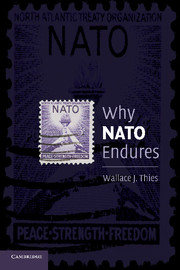Book contents
3 - Creating a Contentious Alliance
Published online by Cambridge University Press: 05 June 2012
Summary
What exactly is the Atlantic Alliance? Why and how was it formed? The farther the creation of the Alliance recedes into the past, the blurrier the answers to these questions seem to become.
On one side are those who see the Alliance as “no more than a classical defense alliance,” “based on a shared perception of threat from the Soviet Union,” and thus vulnerable to collapse once the common enemy disappeared. Regardless of how it is done, any attempt to squeeze NATO into a generic category labeled “alliances” is likely to conceal much more than it reveals. The alliances of eighteenth- and nineteenth-century Europe, as we saw in Chapter 2, were formed by statesmen whose idea of partnership was crafting a bargain at a third party's expense, who feared their allies as much if not more than their enemies, and who thus instinctively reacted in ways obstructive of common action whenever an ally was about to secure gains greater than their own. Prior to the changes in warfare made apparent by the Austro-Prussian and Franco-Prussian Wars, the members of these alliances typically sought to use each other to create a diversion or cover a flank while they snatched a province or two from today's enemy, after which they often abandoned each other with alacrity, before their erstwhile ally could win gains too.
- Type
- Chapter
- Information
- Why NATO Endures , pp. 87 - 119Publisher: Cambridge University PressPrint publication year: 2009



